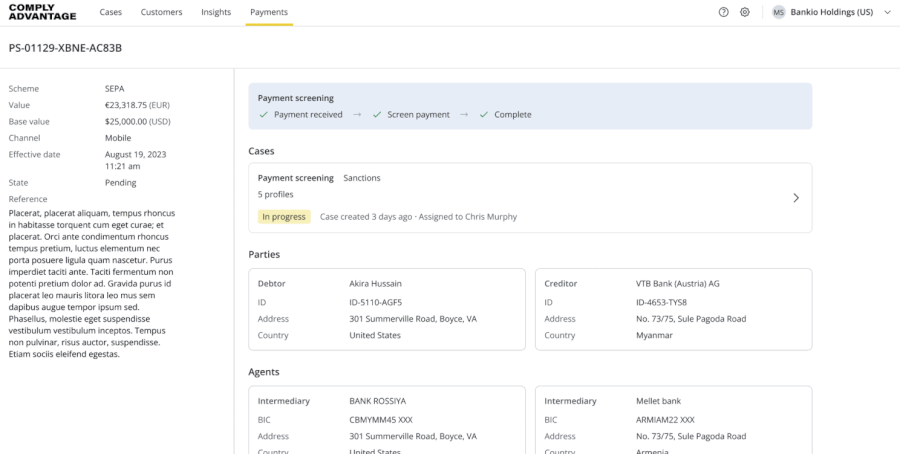

Despite the additional complexities introduced by new regulations and real-time payment rails, customers increasingly expect instant payments and seamless banking experiences as the norm. This puts compliance officers in the eye of a perfect storm: How do they facilitate the delivery of real-time payments to help their firm grow without incurring unnecessary financial crime risks?
An effective payment screening solution is critical to meeting this challenge. Payment screening allows financial institutions (FIs) to detect anti-money laundering and countering the financing of terrorism (AML/CFT) risks associated with a given transaction. This article explores five ways firms can use payment screening to power secure, efficient cross-border payments.
1. Use real-time risk intelligence
Any payment screening solution will only be as good as the data it operates on. An essential stage in the payment screening process is identifying any possible matches between the sender or receiver and sanctioned entities or politically exposed persons (PEPs). For this to happen, firms must have access to up-to-date data.
Keeping pace with ever-changing sanctions lists is a particular issue for firms – particularly in the current geopolitical landscape. Any delays in receiving updates to sanctions data leave firms vulnerable to compliance breaches by inadvertently processing transactions with sanctioned entities and the resulting regulatory penalties.
Firms should look to implement a payment screening solution capable of delivering real-time updates, a feature made possible by using machine learning (ML) to monitor sanctions lists continuously without relying on manual checks. This is particularly important given that legislation around new instant payment rails, such as the 2024 SEPA Instant Credit Transfer regulations, state that payment service providers (PSPs) should screen customers against sanctions lists at least daily, enabling them to facilitate real-time payments more effectively. This only makes access to the latest data more crucial for firms.
2. Adopt tailored screening for a risk-based approach
The risk-based approach – which involves tailoring compliance policies and internal controls to the specific risks a firm is likely to face and its appetite for taking on risk – is a cornerstone of AML compliance. This is because it can help firms balance regulatory obligations with business goals by guiding where resources should be allocated to mitigate risks. When assessing firms’ compliance programs, regulators and auditors will look for evidence of a risk-based approach.
Implemented effectively, a risk-based payment screening solution can identify AML threats without unnecessarily impeding payments (and deterring customers) with needless delays or a one-size-fits-all solution.
There are a few steps firms can take to make their payment screening efficient and risk-based. One is adapting screening searches based on jurisdiction and applicable regulations: screening against irrelevant sanctions lists is one clear example of regulatory ‘over-compliance’ that can slow down payment processing. FIs can also adapt their screening settings based on the level of due diligence required – for example, by altering the fuzziness of searches to cast a wider or narrower net.
3. Get a holistic view of risk
Compliance analysts risk overlooking critical information without a clear, consolidated view of cases and alerts, which impedes their ability to make decisions on cases and increases resolution times. Firms should, therefore, ensure that their understanding of transaction risks is as complete as possible, particularly when assessing risk factors across multiple jurisdictions.
From an analyst’s point of view, a single view of transaction risks allows for smoother, less fragmented decision-making while screening against multiple data fields related to a payment – such as party names, bank identification codes (BICs), and payment references – can increase risk visibility.
Firms should also consider using separate vendors to meet different compliance needs or consolidate their compliance tools. Solutions that allow firms to integrate payment screening with other AML processes, such as customer screening or ongoing transaction monitoring, will allow them to fully understand the risks attached to a payment and remove the need for analysts to switch between different datasets and user interfaces when assessing cases.
4. Balance security with transaction speed
The rise of instant payment services such as SEPA ICT in the European Union or FedNow in the United States has increased the pressure on firms to cut down on transaction processing times. Under the SEPA ICT regulations, firms must deliver payments within ten seconds; in reality, consumer demand means ambitious firms will aim for timelines closer to a few milliseconds.
Screening systems that take longer than this to assess most payments lead to delays that hinder both customer satisfaction and compliance performance due to increased pressure on analysts. These backlogs may also lead to non-adherence to processing service level agreements (SLAs).
Firms should prioritize a payment screening solution that can process transactions without delay. In part, this comes from keeping false positive rates as low as possible. Tailored rules and configurable screening can help firms with this. Precise matching algorithms that use natural language processing to account for factors like variations in spelling or global naming conventions are also particularly important when firms are processing payments to and from multiple locations. FIs should also choose one that supports multiple international instant payment corridors to attract and retain as many customers as possible.

Get your demo of Payment Screening on Mesh
Do more with the ComplyAdvantage Mesh platform - explore its capabilities live with one of our experts.
Get a demo5. Optimize compliance workflows
Internal compliance processes can make or break many aspects of firms’ payment screening performance. Broken workflows make it harder for teams to take quick and decisive action, for example, where data or case decisions are stored via manually updated spreadsheets or other internal documents. When it comes to screening software, usability features that can enhance teams’ operational agility are as important as high-quality data or support for instant payment corridors.
Ideally, solutions should include strong case management capabilities, allowing compliance teams to access user insights and a comprehensive audit trail. Solutions that capitalize on leading-edge technology can be a difference-maker for firms here. ML can speed up lower-risk work so compliance officers can apply their expertise to higher-risk tasks via automated event and customer risk-scoring features. Automated case decision records allow analysts to access a comprehensive audit trail, while insights and performance dashboards can help firms understand and improve the effectiveness of their compliance programs.
Advanced payment screening for firms processing cross-border transactions
ComplyAdvantage Mesh Payment Screening is designed to safeguard cross-border payments without compromising on transaction speed. Firms can process payments faster to stay ahead of regulatory requirements and build customer loyalty with product features including:
- Real-time sanctions updates: Receive system-wide updates to sanctions lists in under an hour, with information sourced directly from regulators and refreshed using automated systems.
- 99% straight-through processing success rate: Screen and process payments in under half a second with a solution that can support any instant payment type or corridor.
- Advanced screening configurations: Choose specific sanction sources to screen against, apply different levels of fuzziness to different searches, and screen against various fields such as payment parties, payment references, and BICs.
- Unified risk management: Gain a consolidated view of all alerts for any given case and improve analyst productivity with alert muting or whitelisting capabilities to minimize wasted time.
- Client-ready API documentation: Enhance compliance team workflows via an easy-to-implement screening solution and configurable case workflows.

With ComplyAdvantage Mesh, firms can integrate their customer screening with other AML capabilities via a single API. Mesh centralizes compliance elements that are usually split over different systems, giving businesses a 360-degree view of their financial crime risk. It also comes with interactive, pre-configured dashboards that allow firms to gain insights into key risk and performance metrics.
Get your demo of Payment Screening on Mesh
Do more with the ComplyAdvantage Mesh platform - explore its capabilities live with one of our experts.
Get a demoOriginally published 06 November 2024, updated 04 February 2025
Disclaimer: This is for general information only. The information presented does not constitute legal advice. ComplyAdvantage accepts no responsibility for any information contained herein and disclaims and excludes any liability in respect of the contents or for action taken based on this information.
Copyright © 2025 IVXS UK Limited (trading as ComplyAdvantage).
